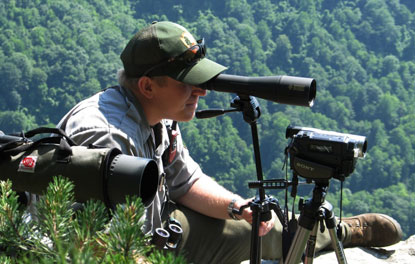|
You are viewing ARCHIVED content published online before January 20, 2025.
Please note that this content is NOT UPDATED, and links may not work. For current information,
visit https://www.nps.gov/aboutus/news/index.htm.

NPS
Contact: Matt Varner, 304 465-6542 “Every year at this time, we ask the public to help increase the likelihood that peregrine falcons might select a nesting site along the Endless Wall,” said Debbie Darden, Acting Superintendent for the National Park Service (NPS) at New River Gorge National River. “By using other locations for hiking and rock climbing for the next two months, local residents and visitors will help create the environment preferred by these magnificent birds, which includes areas with minimal human activity,” Darden explained. The National Park Service has conducted limited monitoring every year since peregrines were reintroduced to the park in 1987-1990, but no nesting pairs have been found. Last year, NPS Wildlife Biologist Matt Varner initiated a multi-year restoration program for the peregrine falcon, and 15 young peregrines were released into the Gorge. “Although it is unlikely that the falcons released in 2006 will return this year to breed, any falcon observations within the gorge are considered a positive indication of the project’s overall success. The NPS believes human activity during the bird’s critical “courtship” period in early spring may be one of the key reasons that no nesting activity has been observed in New River Gorge in the past,” said Varner. “Thus, we are asking the public to avoid using the area between the easternmost segment of the Endless Wall trail and the Keeney’s Creek drainage between February 12th and April 27th.” Known for its speed, beauty, and agility, the peregrine is a member of the falcon family, a group of birds marked by pointed wings, narrow tails, and strong rapid wing beats. Historically, peregrines nested in cliffs and rocky outcrops of the Appalachian Mountains. In the 1950s and 1960s its population in the eastern United States was decimated by the widespread use of pesticides. DDT and other chlorinated hydrocarbons in the food chain caused thinning of the eggshells, resulting in the eggs being broken during incubation. Reintroduction programs are gradually returning the peregrine to its former range throughout North America. For the next two months, the NPS requests that persons planning to hike or climb near the Endless Wall consider using alternative locations to ensure the effectiveness of this monitoring program. Sites offering similar recreational opportunities are listed below. Additional information can be obtained at the NPS Canyon Rim Visitor Center. |
Last updated: February 26, 2015
